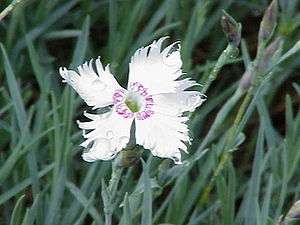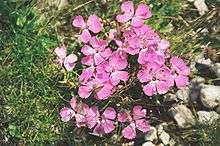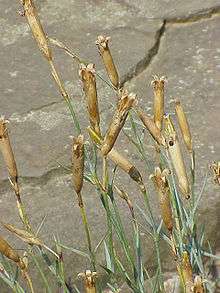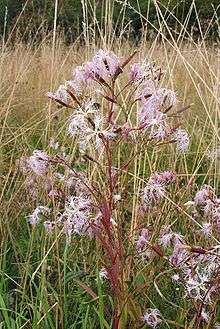Dianthus
< Horticulture| Pinks and Carnations | |
|---|---|
 | |
| Genus: | Dianthus |
| Family: | Caryophyllaceae |
| Pollination: | Insects |
Dianthus is a genus of about 300 species of flowering plants in the family Caryophyllaceae, native mainly to Europe and Asia, with a few species extending south to north Africa, and one species (D. repens) in arctic North America. Common names include carnation (D. caryophyllus), pink (D. plumarius and related species) and sweet william (D. barbatus). The name Dianthus is from the Greek words dios ("god") and anthos ("flower"), and was cited by the Greek botanist Theophrastus.
The color pink may actually be named after the flower. The origin of the flower name 'pink' is unknown.
Description
The species are mostly perennial herbs, a few are annual or biennial, and some are low subshrubs with woody basal stems. Stems are swollen at the nodes, and contain a clear sap.
The leaves are opposite and simple with entire margins and petioles that wrap around the stem, mostly linear and often strongly glaucous grey-green to blue-green.
The flowers are solitary or in panicles, with leafy bracts beneath and five petals, typically with a frilled or notched margin. In almost all species they are pale to dark pink, but at least one species (D. knappii) has yellow flowers with a purple centre.
Growing conditions
Moist, well-drained, not overly rich soils, full sun.
Species
- Dianthus alpinus

- Dianthus amurensis
- Dianthus anatolicus
- Dianthus arenarius
- Dianthus armeria - Deptford Pink
- Dianthus barbatus - Sweet William
- Dianthus biflorus
- Dianthus brevicaulis
- Dianthus callizonus
- Dianthus campestris
- Dianthus capitatus
- Dianthus carthusianorum - Carthusian Pink
- Dianthus caryophyllus - Carnation or Clove Pink

- Dianthus chinensis - China pink
- Dianthus cruentus
- Dianthus deltoides - Maiden Pink
- Dianthus erinaceus
- Dianthus freynii
- Dianthus fruticosus
- Dianthus furcatus
- Dianthus gallicus - French Pink or Jersey Pink
- Dianthus giganteus
- Dianthus glacialis
- Dianthus gracilis
- Dianthus graniticus
- Dianthus gratianopolitanus - Cheddar Pink
- Dianthus haematocalyx
- Dianthus knappii
- Dianthus lusitanus
- Dianthus microlepsis
- Dianthus monspessulanus
- Dianthus myrtinervius
- Dianthus nardiformis
- Dianthus nitidus
- Dianthus pavonius
- Dianthus petraeus

- Dianthus pinifolius
- Dianthus plumarius - Wild Pink
- Dianthus pungens
- Dianthus repens - Boreal Carnation
- Dianthus scardicus
- Dianthus seguieri
- Dianthus simulans
- Dianthus spiculifolius
- Dianthus squarrosus
- Dianthus subacaulis
- Dianthus superbus - Large Pink
- Dianthus sylvestris
- Dianthus zonatus
Uses
Some species are grown for cut flowers, but most as ground covers or border plants.
Pests and diseases
Bacterial Wilts
- Pseudomonas caryophylli
Bacterial Leaf Spots
- Pseudomonas woodsii
- Xanthomonas oryxae var. dianthi
Fasciation
- Corynebacterium fascians
Crown Galls
- Agrobacterium tumeifasciens
- Septoria dianthi
Leaf Blotch
- Zygophiala jamaicensis
- Botrytis cinerea
Bud Rot
- Fusarium poae
- Armillaria mellea
- Fusarium oxysporum var. barbari
- Fusarium oxysporum var. dianthi
- Fusarium roseum var. cerealis
- Phialophora cinerescens
Stem Rots
- Alternaria dianthi
- Pellicularia filamentosa
Crown Rot
Rust
- Puccinia arenariae
- Uromyces dianthi
Smut
- Ustilago violacea
Viri Leaf Streak
- Carnation Streak Virus
Mosaic
- Carnation Mosaic Virus (vectored by Myzus persicae)
Mottle
- Carnation Mottle Virus
Ringspot
- Carnation Ringspot Virus
- Meliodgyne incognita
- Foxglove Aphid: Acyrthosiphon solani
- Bean Aphid: Aphis fabae
- Green Peach Aphid: Myzus persicae
Grasshoppers
- Western Flower Thrips: Frankliniella occidentalis
- Onion Thrips: Thrips tabaci
- Obliquebanded Leafroller: Choristoneura rosaceana
- Corn Earworm: Heliothis zea
- Variegated Cutworm: Peridroma saucia
- Cabbage Looper: Trichoplusia ni
- Greenhouse Leaftier: Udea rubigalis
- w:Cabbage Moth, w:Double-striped Pug, w:Large Yellow Underwing and The Lychnis Also three species of w:Coleophora case-bearers feed exclusively on Dianthus: C. dianthi, C. dianthivora and C. musculella (which feeds exclusively on D. suberbus).
- Twospotted Spider Mite: Tetranychus urticae
Sowbugs
Slugs and Snails
References
- Christopher Brickell and Judith D. Zuk (1997). The American Horticultural Society A-Z Encyclopedia of Garden Plants. DK Publishing. pp. 358-361.
- Staff of the L. H. Bailey Hortorium (1976). Hortus Third: A Concise Dictionary of Plants Cultivated in the United States and Canada. Cornell University Press. pp. 376-380.
- Pirone, Pascal P. (1978). Diseases & Pests of Ornamental Plants (Fifth Edition ed.). John Wiley & Sons, New York. pp. 198.
- Cranshaw, Whitney (2004). Garden Insects of North America: The Ultimate Guide to Backyard Bugs. Princeton University Press. pp. 592.
- Pippa Greenwood, Andrew Halstead, A.R. Chase, Daniel Gilrein (2000). American Horticultural Society Pests & Diseases: The Complete Guide to Preventing, Identifying, and Treating Plant Problems (First Edition ed.). Dorling Kindersley (DK) Publishing, inc.. pp. 198.